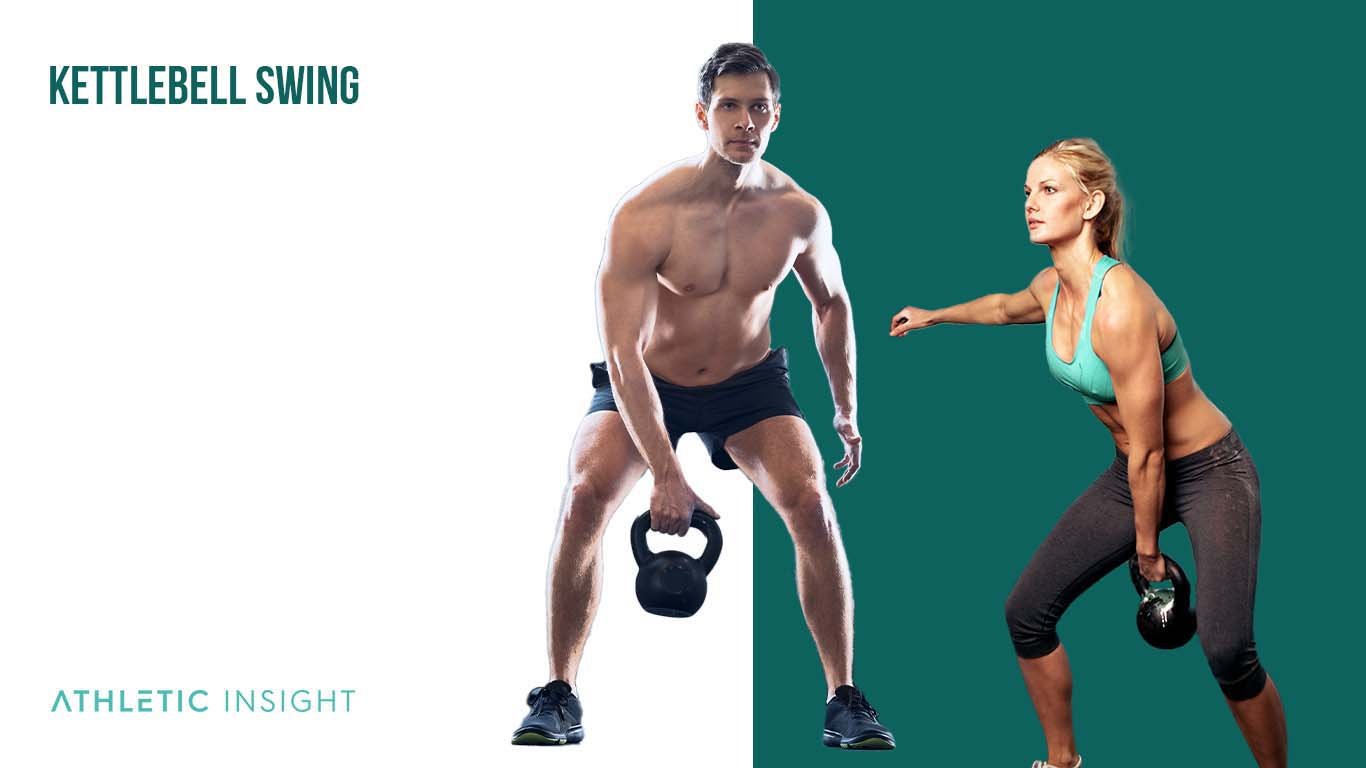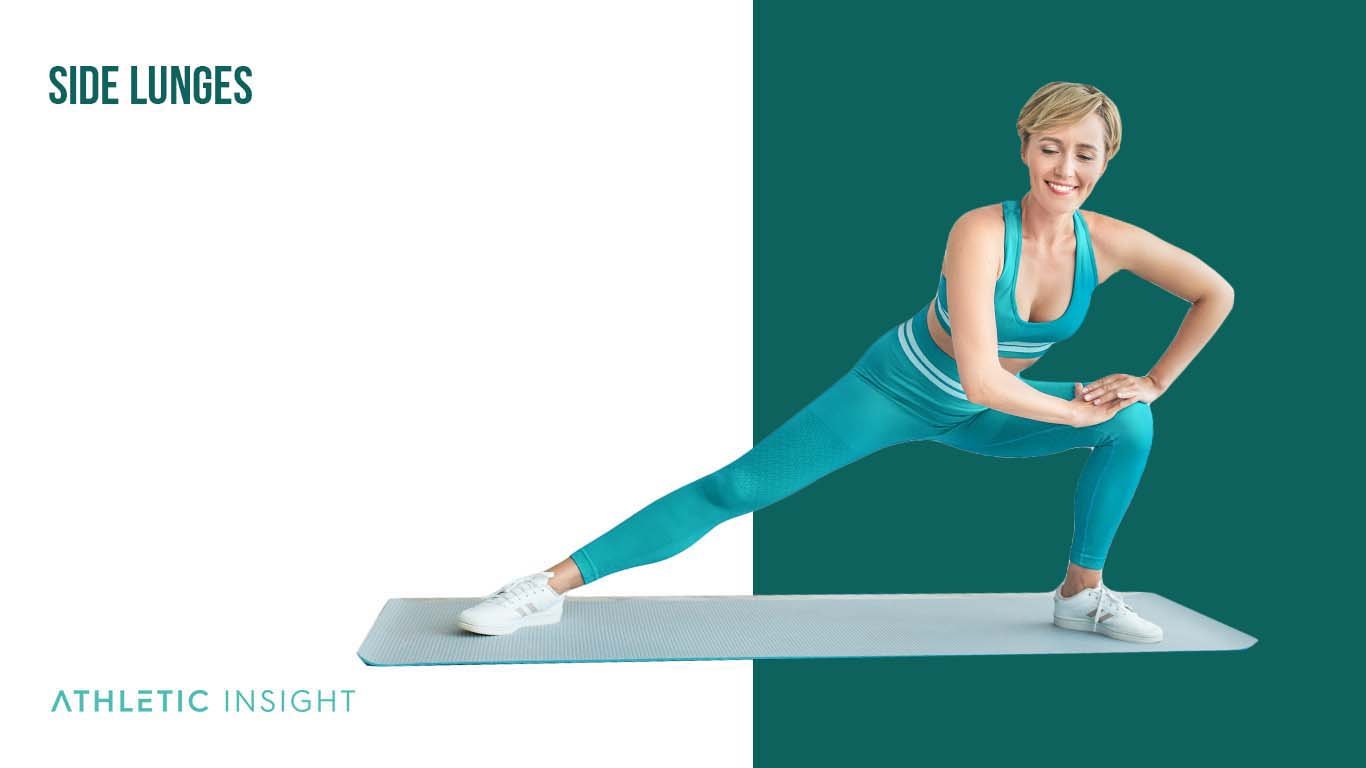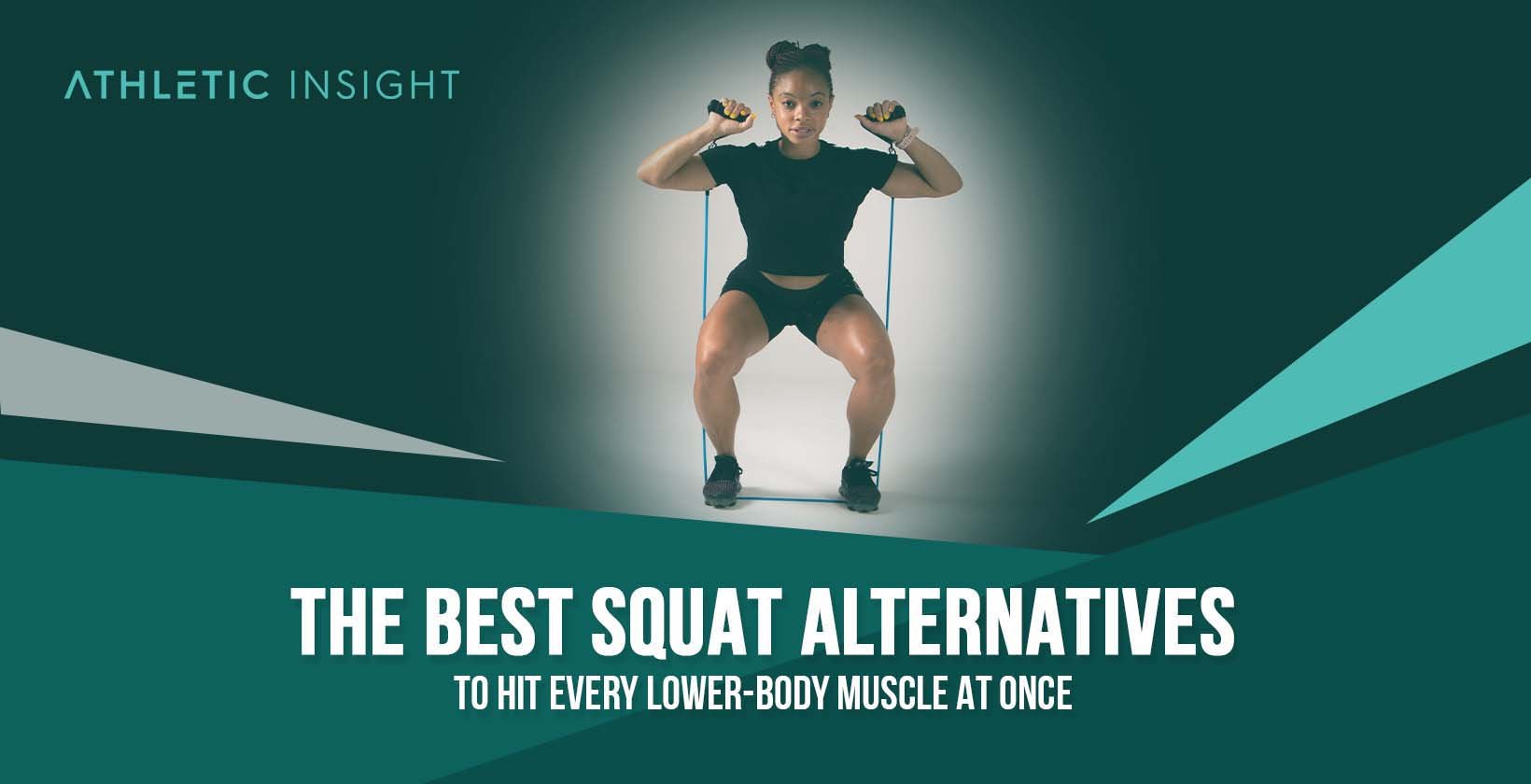The squat is one of the most popular exercises for boosting strength, athletic performance, and muscle tone. It works all of your lower-body muscles, including your glutes, hamstrings, gastrocnemius, quadriceps femoris, hip flexors, and adductor longus. Squats are a popular beginner-friendly exercise for weightlifters, bodybuilders, and athletes, and adding weights can increase skill and strength levels.
Squats may not always be ideal for athletes that struggle with knee pain or if you want to target specific muscles, like the rectus abdominis muscle. Alternatives may also be appropriate if you’re improving strength or building endurance. The deadlift, for instance, can be ideal for strength-building and may be more popular for weightlifters.
Most squat alternatives, mainly when used in tandem with one another, will target all of your major lower-body muscle groups. You should choose 3-5 of the exercises here and do each in 3 sets of 8-12.
1. Glute Bridge
The glute bridge is a squat alternative that focuses on the gluteus maximus and hips and maybe an ideal alternative for male and female athletes who struggle with back, hip, or knee pain when squatting. It removes the pressure that typically goes on the knees during a squat. It’s beginner-friendly and easy to scale as you build strength and flexibility.
Keep the feet flat and shoulder-width apart with the arms palms-down when performing the glute bridge. This stance can help isolate the core and rear, but the position can be readjusted if there’s too much pressure on the knees. When you’ve mastered the standard glute bridge, you can add in a bit of difficulty by lifting one leg up as you raise the hips.
A common mistake when performing the glute bridge is not overextending the lower back during the bridge.
The single-leg variation is also another alternative exercise for squats for those looking for a Bulgarian split squat alternative or a squat alternative for a bad back.
2. Hip Hinge
The hip hinge is an alternative to the squat that works the glutes, bicep femoris, and adductor longus, and it’s especially popular for female athletes, who are more at risk for tearing their ACL. It’s a straightforward, beginner-friendly exercise that doesn’t require special equipment, so athletes can do it anywhere. The hip hinge is also the base for other exercises, including the Romanian deadlift.
The main thing to remember with the hip hinge is the importance of keeping a straight back. A good practice is to keep a hand on the lower back as you bend forward as a reminder not to bend the back or roll the shoulders. Athletes can also use a dowel for the same purpose.
Once it feels comfortable performing the hip hinge using only your body weight as resistance, athletes can add more weight to increase the workout’s effectiveness. The hip hinge is a solid choice for athletes and bodybuilders that want a squat alternative that targets your thighs and rear. Some variations of the hip hinge include the following.
- Kettlebell hip hinge
- Resistance band hip hinge
Both variations use added weight to increase resistance and may be more suitable for athletes that want to increase strength with this exercise.
3. Step-Ups
Step-ups are simple, beginner-friendly exercises that work the glutes and quadriceps and are an excellent alternative for male and female athletes with knee pain. They also work as a front squat alternative to mimic the dumbbell step-up. So, the step-up is also one alternative to squats and lunges for bad knees.
Since they focus on the glutes and quadriceps femoris, they are another option to target the muscles and improve mobility in the areas you use most. Athletes can use them as a reverse hack squat alternative or as a substitute for the barbell front squat.
A step-up is an ideal substitute for the squat because it distributes the pressure across the legs instead of focusing it all in one area. Athletes who suffer from pain during squats may prefer to alternate between the squat and step-up.
Some variations of the step-up include the following options.
- Weighted step-up
- Dumbbell step-up
- Goblet step-up
These step-up variations increase strength and work some upper-body muscles, like the trapezius and biceps.
A common mistake when performing the step-up is letting the knees cave in when stepping up, which may increase knee pain. For beginners, starting with a lower step may be more beneficial before moving to a higher step, and moving faster during the step-ups could introduce cardio into the exercise.
4. Rear Lunges
Rear lunges are another beginner-friendly squat alternative that targets the major lower-body muscle groups, including the glutes, quads, hamstrings, hips, and gastrocnemius muscles, making them a popular choice for engaging more of your lower body. This exercise can be ideal for female and male athletes and weightlifters looking to increase strength and balance.
Since it works with lighter weights, the lunge may put less stress on the knees than a squat. If there is knee pain while performing the exercise, try readjusting the position so your chest and torso are tilted forward slightly. For added difficulty, do reps of 8 lunges per side. When performing the rear lunge, a common mistake is not bending the back knee enough, which may strain the hip flexors.
Variations of the rear lunge include the following.
- Slider reverse lunge
- Goblet forward lunge
- Walking lunge
5. Kettlebell Swing
The kettlebell swing is a valuable alternative to the back squat that targets the gluteus maximus and biceps femoris and is popular for beginner female and male weightlifters that want to increase spine strength. Another squat alternative focuses on the lower body while also targeting upper-body muscle groups, like the rectus abdominis muscle and lats.

The kettlebell swing may also be beginner-friendly because the kettlebell movement is more natural. It can help increase power and boost weight loss, but it’s not an adequate squat replacement for those wanting to build muscle.
Like back squats, the kettlebell swing can be an effective exercise for combating lower back pain. However, to ensure they’re not further hurting their back, weightlifters should focus on keeping the back straight and not rounded when swinging. Also, keep your feet planted flat on the ground, refusing the urge to lift your heels. For a more effective form, weightlifters should keep their knees slightly bent.
Some variations of the kettlebell swing include the following options.
- Chest-supported kettlebell swing
- Dead step kettlebell swing
- Alternating kettlebell swing
6. Deadlifts
The deadlift is an excellent squat alternative that targets the glutes, which is a primary focus of the standard squat and is often popular for female and male bodybuilders and weightlifters.

The hamstrings and glutes do the bulk of the work in a deadlift, making it a suitable alternative to the squat. A common mistake many lifters make during the deadlift is bending their back. When performing the exercise, be sure to keep the back and legs straight. Otherwise, the exercise could put unnecessary pressure on the knees.
A few other tips for performing this exercise more effectively include keeping the bar closer to the body and working on building a more robust stance.
The single-leg Romanian deadlift is a good split squat alternative for testing out deadlift variations. It’s not very beginner-friendly, though, so those with little experience should proceed with caution.
7. Side Lunges
Side lunges are a worthwhile squat alternative because they target the quadriceps femoris, adductor longus, glutes, abductors, and biceps femoris. It is ideal for female and male weightlifters and can be a suitable warm-up exercise before lifting.

Those target areas mean you can substitute your lateral or Cossack squats with side lunges to get a similar effect. Side lunges, also known as lateral lunges, can also be a suitable sissy squat alternative, so keep that in mind when choosing your exercise.
When appropriately performed with the hips back and the weight evenly distributed, it can take a lot of the pressure off the knees. If you suffer from knee pain or are easing back into your routine, the side lunges may be a suitable squat alternative.
However, the side lunge isn’t as beginner-friendly as the squat due to the mobility and agility required to complete the movement successfully. As a result, some might struggle to keep their bodies in line with the exercise when performing the side lunge. However, you can easily tweak your form to make the movement easier if that happens. For best results, don’t slouch, evenly distribute weight on the feet, and don’t let the knees cave in.
Some variations to the side lunge include the following.
- Walking lunge
- Jump lunge
- Lateral lunge
8. Foldover
The foldover targets the rectus abdominis muscle and the glutes and is ideal for male and female runners that need to increase their stamina. Since it’s an advanced move, beginners might need some time to work up to it.
Since there are many moving parts in the foldover, runners may need to focus on keeping their core rigid and avoid any pressure on the back muscles. The foldover exercise has a solid focus on the glutes, not the back, which makes it another great squat alternative for a bad back.
A common mistake when performing the foldover is not squeezing the chair tight enough. For a more effective form, squeeze until the leg is barely able to pulse up and alternate sides after you’ve done several reps.
What to Know About Squat Alternatives
Facts about squat alternatives are listed below.
- Muscle growth: Squat alternatives can benefit certain muscle groups better than regular squats, like the kettlebell swing or foldover.
- Beginner-Friendly: Although there are some more advanced moves on this list, many squat alternatives, many squat alternatives, like the step-up, can be more beginner-friendly.
- Easing Joint Pain: Squats can be difficult on the knees and may not be ideal for someone with bad knees, which is why some squat alternatives may be the better choice.
While squats may be one of the most popular exercises for working the lower body, using squat alternatives can help you target specific muscle groups or help you find ways to work around joint pain.
Which Squat Alternative Is Beginner Friendly?
Step-ups are the most beginner-friendly squat alternative and are generally one of the most straightforward exercises for beginners if you want to replace the squat.
You can start performing them with no special equipment, then increase the exercise’s difficulty by adding weight and gradually increasing it over time. The step-ups are also a good barbell squat alternative, so if that’s one of your go-to exercises, the step-up will be a good choice.
Which Squat Alternative Is Better for Legs?
The best squat alternative that’s better for legs is the side lunge. Side lunges can put all of your leg muscle groups to work, making them one of the best leg exercises. You’ll target your glutes, hamstrings, calves, quads, hips, and inner thighs throughout the entire exercise. The side lunge is also a good choice for improving your balance and increasing mobility.
Which Squat Replacement Is Better for Quads?
The squat replacement that’s better for quads is the glute bridge. The quads are the main focus in many squat variations, so if you’re looking for the best quads exercises to substitute the squat, the glute bridge will work well. Although the glute bridge doesn’t offer a specific hack squat machine alternative, you can get by without it. The glute bridge is also an excellent Bulgarian split squat alternative, a standard replacement for the hack squat.
Which Squat Substitute Is Better for Strength?
The best squat substitute for strength is the deadlift. The deadlift is an ideal substitute for the squat if you want to focus on whole-body benefits, including strength. Since the focus of the exercise is on weight-lifting, you can use this exercise to strengthen all of your critical lower-body muscle groups.
When Should an Athlete Use Squat Alternatives for Exercise?
An athlete should use squat alternatives for exercise when trying to alleviate back, knee, or hip pain. In some cases, squats might put too much pressure on your lower back or knees, leading to pain or difficulty performing exercises. Choosing a new routine that takes the pressure off those areas can be a great way to continue your workout without losing time or progress.
What Are the Advantages of Substituting the Squat?
The main advantage of substituting the squat is that you can continue your workout with minimal interruption. In addition, pivoting to a new squat exercise that will alleviate stress on certain areas will offer similar benefits to the standard squats while providing those areas time to recover.
Which Squat Alternative Is Safer?
The safest squat alternative to perform is the step-up, although all of these exercises can be safe when performed correctly. The step-up requires no special equipment, mimics an everyday daily movement, and can be performed anywhere.
Can Squat Alternatives Replace the Squat?
Yes, squat alternatives can replace the squat. But although squat alternatives can replace the squat to an extent, it’s best to use them as a temporary substitute. Ideally, you’ll alternate the squat replacements with the squat exercises you perform as part of your regular routine.
It’s important to note that some squat variations are difficult to substitute because they’re pretty unique. For example, there isn’t a very good landmine squat alternative that isn’t simply another squat variation. In addition, you might struggle to find a good smith machine squat alternative because you’ll need to replicate the machine’s movements.
What Are the Squat Variations?
There are dozens of squat variations you can try if you want to replace your squats in your regular routine, such as:
- Wall squats
- Side squats
- Prisoner squats
- Side-kick squat
- Weighted squats
Wall squats can be a great variation if you’re trying to improve endurance more than strength, while side squats are perfect for athletes looking to work on their dynamic balance and flexibility.
Prisoner squats engage the core, but if you’re a runner, you may prefer the side-kick, which is more of a cardio workout. Weighted squats are another tremendous squat variation for weightlifters who want to get their upper body muscles, like the biceps, into the workout.



